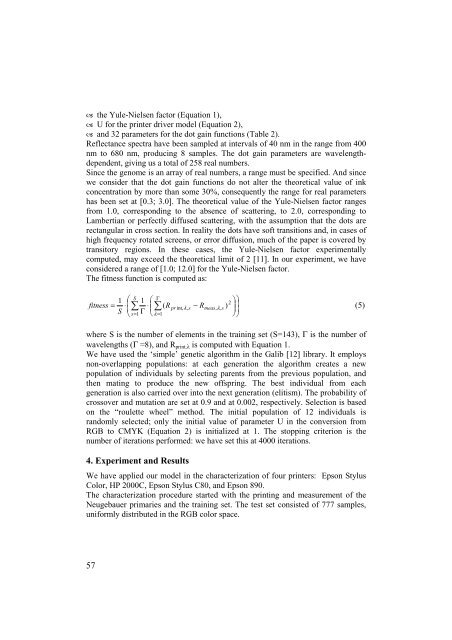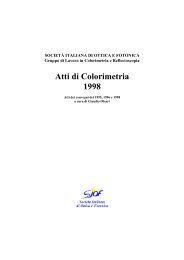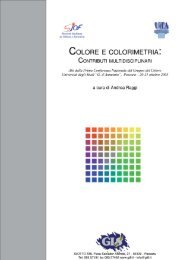Scarica gli atti - Gruppo del Colore
Scarica gli atti - Gruppo del Colore
Scarica gli atti - Gruppo del Colore
You also want an ePaper? Increase the reach of your titles
YUMPU automatically turns print PDFs into web optimized ePapers that Google loves.
� the Yule-Nielsen factor (Equation 1),<br />
� U for the printer driver mo<strong>del</strong> (Equation 2),<br />
� and 32 parameters for the dot gain functions (Table 2).<br />
Reflectance spectra have been sampled at intervals of 40 nm in the range from 400<br />
nm to 680 nm, producing 8 samples. The dot gain parameters are wavelengthdependent,<br />
giving us a total of 258 real numbers.<br />
Since the genome is an array of real numbers, a range must be specified. And since<br />
we consider that the dot gain functions do not alter the theoretical value of ink<br />
concentration by more than some 30%, consequently the range for real parameters<br />
has been set at [0.3; 3.0]. The theoretical value of the Yule-Nielsen factor ranges<br />
from 1.0, corresponding to the absence of scattering, to 2.0, corresponding to<br />
Lambertian or perfectly diffused scattering, with the assumption that the dots are<br />
rectangular in cross section. In reality the dots have soft transitions and, in cases of<br />
high frequency rotated screens, or error diffusion, much of the paper is covered by<br />
transitory regions. In these cases, the Yule-Nielsen factor experimentally<br />
computed, may exceed the theoretical limit of 2 [11]. In our experiment, we have<br />
considered a range of [1.0; 12.0] for the Yule-Nielsen factor.<br />
The fitness function is computed as:<br />
fitness<br />
57<br />
1 ⎛<br />
⋅ ⎜<br />
S ⎜<br />
⎝<br />
S<br />
1 ⎛<br />
⋅<br />
⎜<br />
Γ ⎝<br />
Γ<br />
= ∑ ∑<br />
s=<br />
1 λ=<br />
1<br />
( R<br />
pr int,<br />
⎞ 2 ⎞<br />
⎟<br />
λ , s − Rmeas,<br />
λ,<br />
s )<br />
⎟<br />
(5)<br />
⎟<br />
⎠⎠<br />
where S is the number of elements in the training set (S=143), Γ is the number of<br />
wavelengths (Γ =8), and Rprint,λ is computed with Equation 1.<br />
We have used the ‘simple’ genetic algorithm in the Galib [12] library. It employs<br />
non-overlapping populations: at each generation the algorithm creates a new<br />
population of individuals by selecting parents from the previous population, and<br />
then mating to produce the new offspring. The best individual from each<br />
generation is also carried over into the next generation (elitism). The probability of<br />
crossover and mutation are set at 0.9 and at 0.002, respectively. Selection is based<br />
on the “roulette wheel” method. The initial population of 12 individuals is<br />
randomly selected; only the initial value of parameter U in the conversion from<br />
RGB to CMYK (Equation 2) is initialized at 1. The stopping criterion is the<br />
number of iterations performed: we have set this at 4000 iterations.<br />
4. Experiment and Results<br />
We have applied our mo<strong>del</strong> in the characterization of four printers: Epson Stylus<br />
Color, HP 2000C, Epson Stylus C80, and Epson 890.<br />
The characterization procedure started with the printing and measurement of the<br />
Neugebauer primaries and the training set. The test set consisted of 777 samples,<br />
uniformly distributed in the RGB color space.





